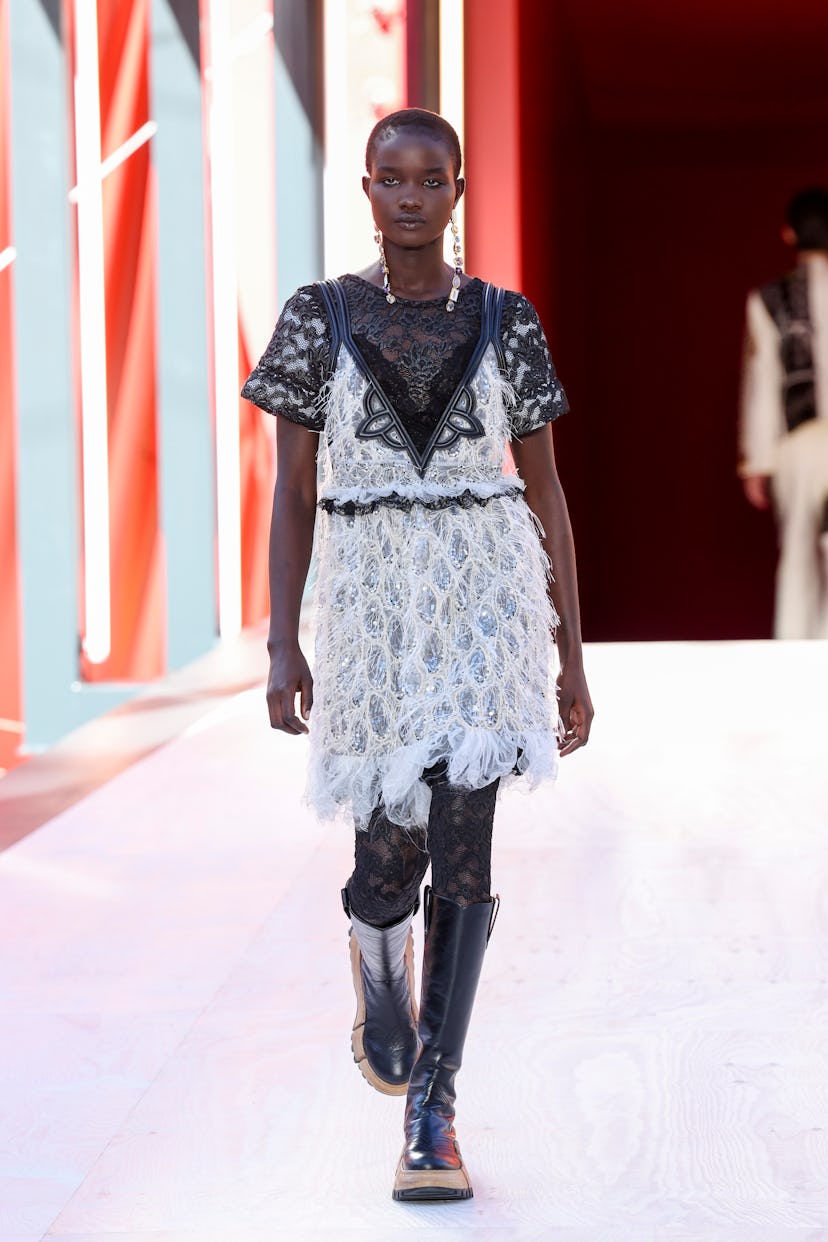Nicolas Ghesquière Supersizes Reality at Louis Vuitton

Dresses with necklines that resemble supersized airplane neck pillows. Belts subverted and reappropriated onto jackets and the legs of pants. Little flippy leather dresses with massive chain shoulders. These were the elements on view at the Louis Vuitton carnival that was its spring 2023 presentation. There, utilitarian details became highly ornamental and the Louvre transformed into a monster flower that also looked like a cherry red circus tent designed by French contemporary artist Philippe Parreno and production designer James Chinlund.
For spring 2023, creative director Nicolas Ghesquière zoomed into the smallest of functional details and supersized them for maximum impact. Teeny dresses drowned in big zippers, squiggly line patterns mixed with giant buttons, bows became larger than life, and giant waist-cincher belts flanked leather babydoll dresses.
Overall, there were different layers and levels of humor in the collection. A Victorian dollhouse was carried as a bag. Harnesses dripped off of dresses with floppy, undone belts in jumbo sizes. And the zippers that came on graphic outerwear, pants and sweaters went beyond the size of even the boldest and biggest pieces of jewelry.
Ghesquière has defined the aesthetic of Louis Vuitton by getting a firm grasp on newness and the ease of change—but spring 2023 felt extra playful in a way we hadn’t quite seen from the brand before. The roots and craftsmanship of the typical Louis Vuitton collection were all there, seen through the lush patchwork leathers, cargo pockets done in immaculate form, mermaid-blue textured trousers, and tiger print coats.
But Ghesquière also took trompe l’oeil to another level, with embroidery that resembled macro versions of tweed. The design team used 3-D scanners to transfer fabric images to computers and blow them up to 500 percent, in order to highlight each thread and all of its texture. A blouse closure from Ghesquière’s second collection was zoomed in on and turned into an entire dress. “There’s an emphasis on the identifiers of femininity,” the designer said in a statement. “I took a lot of details from previous collections and highlighted them; I deliberately showed because creativity is circular, it loops back...like the layout of Philippe’s set: a luminous circle around this strange flower.”
The excess of it all felt like a pause (or refresher) in the sometimes-stiff universe of Louis Vuitton. “What could outrageous femininity be—the idea of outrageousness in femininity, the clichés of ultra-femininity—as seen stylistically through a ‘female gaze?’” asked Ghesquière in a statement. “The way of zooming in on the details of a garment that interests women because they know them so well. You could say that I approached hyper-femininity in its most literal sense. Emphasized it. Changed the play of proportions, found a new balance in scale.”
The collection felt hyperreal in its distorted proportions, since it also revealed a sense of mixed reality. We’re in an era in which the lines are constantly blurred between real life and our phones, even at the very shows happening during fashion month—pinching our screens to zoom in for a closer look, or watching through the screens of others. Ghesquière perfectly cemented a collection to end fashion month—with a sort of black humor take on voyeurism and how it can be transformed into a fleeting fashion moment that still feels covetable.